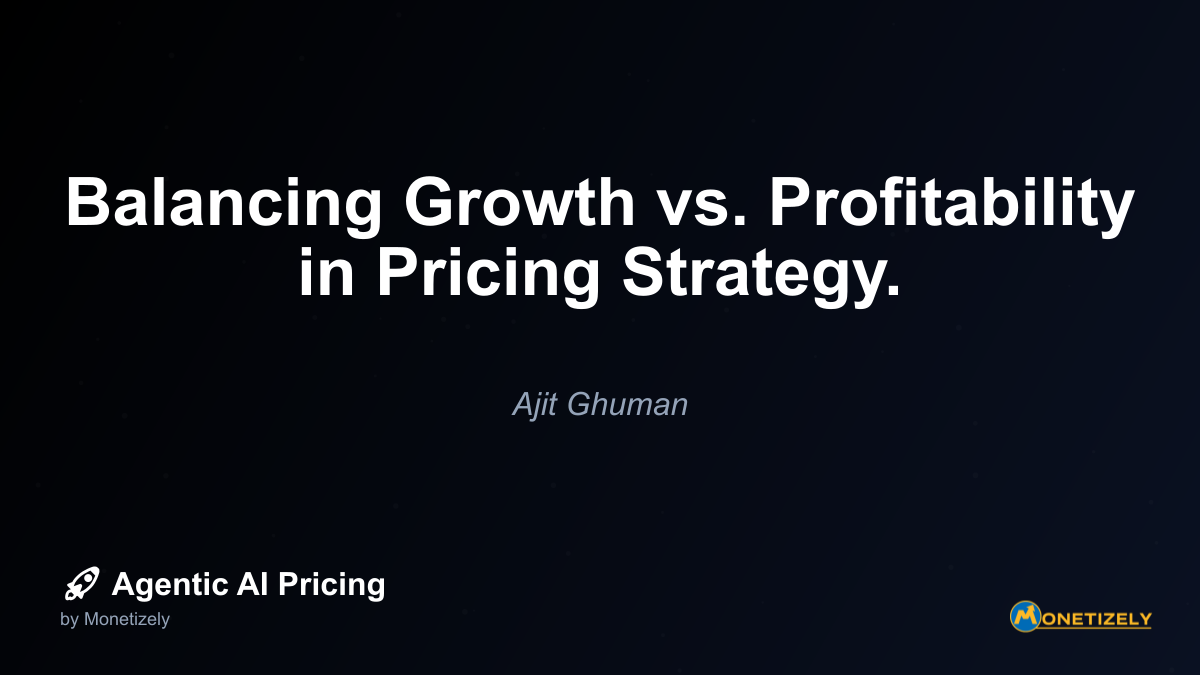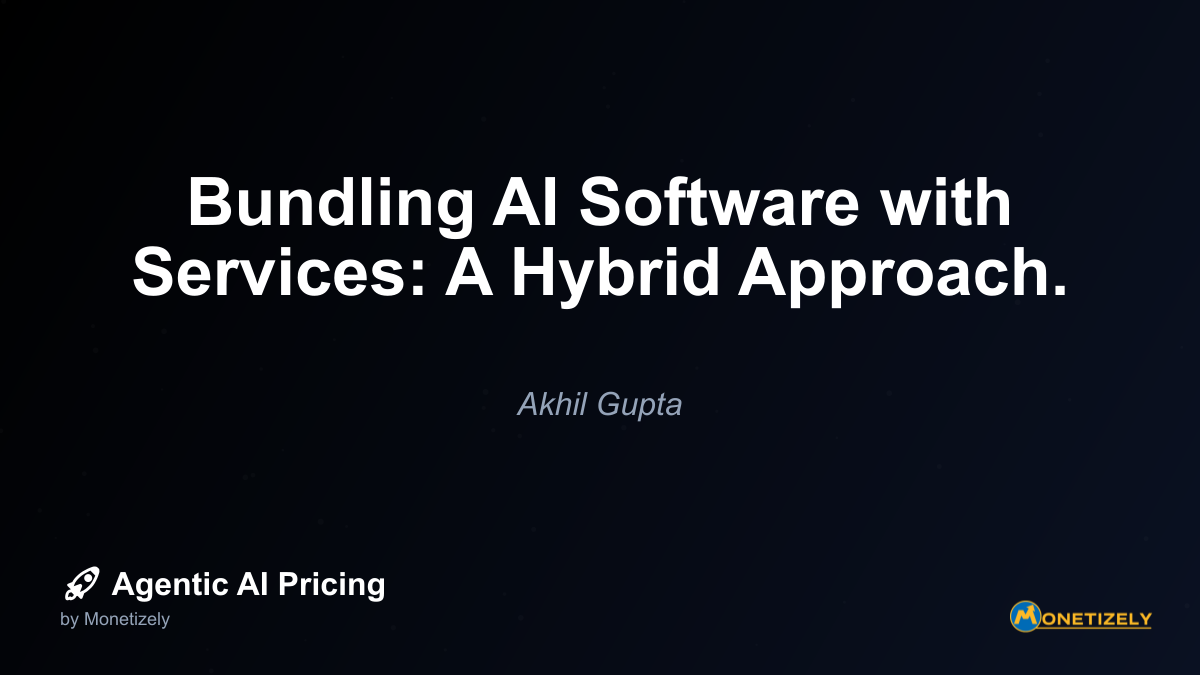· Ajit Ghuman · Strategy & Planning · 7 min read
Upselling in a Usage-Based World: Growing Accounts Post-Sale.
AI and SaaS Pricing Masterclass
Learn the art of strategic pricing directly from industry experts. Our comprehensive course provides frameworks and methodologies for optimizing your pricing strategy in the evolving AI landscape. Earn a professional certification that can be imported directly to your LinkedIn profile.

Aligning Customer Success for Usage Growth
In a usage-based world, customer success becomes the primary driver of account expansion. This requires rethinking the customer success function and its alignment with sales and product teams.
Evolving the Customer Success Charter
Traditional customer success metrics like retention and satisfaction remain important, but in usage-based models, they must be supplemented with usage growth metrics. Customer success teams should be explicitly chartered with driving increased consumption through value delivery.
Key performance indicators might include:
- Month-over-month usage growth rates
- Expansion of use cases per customer
- Feature adoption rates
- Value realization metrics
- Usage-to-value ratio (measuring efficiency of usage)
Implementing Usage Monitoring and Alerting
Customer success teams need visibility into usage patterns to identify both opportunities and risks. Implement systems that provide:
- Real-time usage dashboards
- Trend analysis and forecasting
- Anomaly detection for sudden changes
- Comparative benchmarks across similar customers
- Alerts for usage plateaus or declines
These tools enable proactive outreach when usage patterns suggest either expansion opportunities or potential value gaps that could threaten retention.
Creating a Value Acceleration Program
Develop a structured program specifically designed to accelerate value realization and, consequently, usage growth. This program might include:
- Regular cadence of business reviews focused on outcomes
- Technical optimization sessions to improve efficiency
- User enablement workshops to build capabilities
- Executive alignment meetings to ensure strategic fit
- Innovation sessions to explore new applications
For agentic AI solutions, these programs should focus particularly on helping customers understand how to extract maximum value from AI capabilities that may be unfamiliar or rapidly evolving.
Building Cross-Functional Collaboration for Account Growth
In usage-based models, account growth requires tight collaboration across teams that might traditionally operate in silos. Sales, customer success, product, and even engineering all play crucial roles in driving increased usage.
Creating Joint Account Plans
Develop comprehensive account plans that align sales and customer success around usage growth objectives. These plans should include:
- Current usage baseline and growth targets
- Identified expansion opportunities
- Value realization strategies
- Stakeholder mapping and engagement plans
- Risk factors and mitigation strategies
Review and update these plans quarterly to ensure continued alignment and adaptation to changing customer needs.
Establishing Growth Pods
Consider organizing cross-functional “growth pods” that bring together customer success, sales, product, and technical resources to focus on specific high-potential accounts or segments. These pods can develop deep expertise in particular use cases or industries, making them more effective at identifying and capturing expansion opportunities.
Aligning Incentives Across Functions
Ensure that incentive structures across the organization support the goal of usage growth. This might include:
- Customer success compensation tied partially to usage expansion
- Sales commissions that reward post-sale growth, not just initial deals
- Product team objectives linked to feature adoption and usage
- Executive bonuses connected to overall usage metrics
When everyone is rowing in the same direction, the likelihood of successful account expansion increases dramatically.
Leveraging Product-Led Growth in Usage-Based Models
While sales and customer success play critical roles in driving account expansion, the product itself can be designed to encourage increased usage through built-in growth mechanisms.
Implementing In-Product Expansion Triggers
Design the product to identify and suggest new use cases based on user behavior. For example:
- Recommend related workflows based on current usage patterns
- Highlight underutilized features that could deliver additional value
- Suggest integrations with other systems to expand application
- Provide usage insights that demonstrate potential for scaling
These in-product prompts can complement human-led expansion efforts and scale across the entire customer base.
Creating Usage Visualization Tools
Build capabilities that help users visualize their usage and the resulting value. Dashboards that show:
- Usage trends over time
- Value metrics correlated with usage
- Comparison to similar organizations
- Potential value of increased usage
These visualizations make the connection between usage and outcomes tangible for customers, creating intrinsic motivation to expand.
Developing Self-Service Expansion Paths
Make it easy for customers to expand their usage without friction. This might include:
- Simplified processes for adding new use cases
- Self-service onboarding for new teams or departments
- In-product education about advanced features
- Easy access to usage-based pricing tiers and options
The easier it is for customers to expand on their own, the more likely they are to do so.
Navigating the Challenges of Usage-Based Account Expansion
While usage-based models offer significant opportunities for account growth, they also present unique challenges that organizations must address.
Managing Usage Volatility
Unlike predictable seat-based revenue, usage can fluctuate based on customer business cycles, seasonal factors, or changing priorities. This volatility can make forecasting difficult and create anxiety about revenue stability.
Strategies to address this challenge include:
- Implementing minimum usage commitments to establish revenue floors
- Developing sophisticated usage forecasting models based on historical patterns
- Creating usage smoothing options for customers with predictable annual but variable monthly needs
- Building a portfolio of customers across industries with different usage cycles
Avoiding the “Value-Usage Disconnect”
As customers become more efficient with your solution, they may achieve the same or greater value while actually reducing usage—creating a potential revenue decline despite successful outcomes.
To address this challenge:
- Tie pricing to value metrics rather than raw usage where possible
- Create pricing tiers that capture a share of increasing value
- Continuously innovate to provide new capabilities that drive additional usage
- Focus on expanding use cases rather than just intensifying existing ones
Preventing Optimization Backlash
As customers become more sophisticated, they may optimize their usage to minimize costs, potentially leading to revenue erosion.
Mitigation strategies include:
- Emphasizing value delivered rather than cost incurred
- Creating bundled offerings that encourage broad usage
- Implementing value-sharing models where both parties benefit from efficiency
- Developing partnership approaches that align economic interests
Case Study: Transforming Account Expansion in an AI-Powered Analytics Platform
To illustrate these principles in action, consider the following case study of an AI-powered analytics platform that transitioned from a seat-based to a usage-based model.
The Challenge
The company initially sold its agentic AI analytics solution on a per-seat basis, with customers paying for each analyst who needed access. However, this created several issues:
- Usage was concentrated among a small number of power users
- Value was limited to specific departments despite broader potential
- Growth plateaued once the core analytical team was licensed
- Customers questioned ROI when seats were underutilized
The Transformation
The company transitioned to a usage-based model centered on the volume of data processed and insights generated. This fundamental shift required rethinking their entire go-to-market approach:
Sales Strategy: Instead of focusing on the number of potential users, sales conversations centered on use cases and data sources that could drive value.
Customer Success: The CS team was restructured around usage growth, with success managers becoming experts in identifying new data sources and analytical applications.
Product Development: The product was enhanced with self-service capabilities that made it easier for customers to add new data sources and expand use cases.
Pricing Model: The company implemented tiered pricing based on data volume, with decreasing per-unit costs at higher tiers to incentivize consolidation and growth.
The Results
Within 18 months of the transition:
- Average revenue per account increased by 72%
- The number of use cases per customer grew from 2.3 to 6.8
- Customer satisfaction scores improved as value became more visible
- Net revenue retention increased from 108% to 136%
The key to this success was shifting the entire organization’s focus from selling seats to delivering expanding value through increased usage.
Conclusion: Building a Culture of Continuous Expansion
In the usage-based world of agentic AI solutions, account expansion becomes less a discrete sales motion and more a continuous process of value delivery and growth. Success requires a fundamental shift in how organizations think about customer relationships—moving from transactional upselling to collaborative value creation.
This shift demands new capabilities, metrics, and mindsets across the organization. Sales teams must become adept at identifying potential use cases and value opportunities. Customer success must evolve into a growth engine focused on usage expansion. Product teams must build solutions that naturally encourage increased consumption. And leadership must align incentives and resources to support this new approach.
Organizations that master these capabilities will find themselves with a powerful competitive advantage: the ability to grow revenue not through aggressive selling, but by continuously increasing the value they deliver to customers. In a usage-based world, the companies that win are those that help their customers extract maximum value from every unit of consumption—creating a virtuous cycle of usage growth and mutual success.
For businesses navigating the transition to usage-based and outcome-driven pricing models, the path forward is clear: focus relentlessly on value, build systems to identify expansion opportunities, align teams around usage growth, and create incentives that reward increased consumption. By embracing these principles, organizations can transform account expansion from a challenging sales problem into a natural outcome of successful customer partnerships.
As the agentic AI landscape continues to evolve, those who master the art of usage-based account expansion will be positioned not just to survive but to thrive in this new paradigm. The future belongs to those who can grow by helping their customers succeed—one usage increment at a time.
For more insights on navigating the complexities of AI pricing models, explore our comprehensive tutorial on mastering usage-based AI pricing, which provides additional frameworks and strategies for optimizing your approach.
Co-Founder & CEO
Ajit is the author of Price To Scale, a top book on SaaS Pricing and is the Founder of Monetizely. Ajit has led and worked in pricing and product marketing at firms like Twilio, Narvar and Medallia. His work has been featured in Forbes and VentureBeat. Ajit regularly consults with software companies from Seed stage to post-IPO on pricing strategy. Ajit is also a highly-rated co-instructor for 'The Art of SaaS Pricing and Monetization' on Maven.
Pricing Strategy Audit
Let our experts analyze your current pricing strategy and identify opportunities for improvement. Our data-driven assessment will help you unlock untapped revenue potential and optimize your AI pricing approach.




